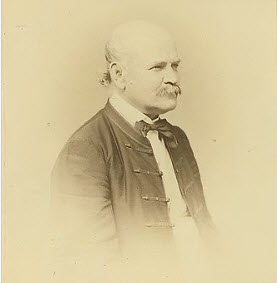
Ignaz Semmelweis (1818-1865) was a Hungarian doctor and is considered a pioneer of antiseptic methods in medicine. Known as the “savior of mothers”, Semmelweis played a crucial role in reducing maternal mortality in maternity hospitals by emphasizing the importance of hand hygiene.
After studying medicine in 1844 and obtaining his doctorate, he specialized in obstetrics and took up a position at the General Hospital in Vienna in 1846.
Discovery of hand hygiene
In the middle of the 19th century, puerperal fever was a common and often fatal disease. At the time, Semmelweis noticed that the mortality rate in the maternity ward attended by doctors was significantly higher than in the ward attended by midwives.
After a thorough investigation, he found that doctors often went straight from working on corpses to assisting in childbirth without washing their hands first!
In 1847, he therefore introduced a rigorous hand-washing practice in his department using chlorinated lime water. As a result, the mortality rate fell drastically from around 10% to 1-2%!
Semmelweis’ conclusion: “cadaveric poison” was the cause of the infections and cleaning the hands could prevent this transmission!

Resistance and later years
Naturally, this met with considerable resistance from his colleagues, as his theory implied that they themselves were responsible for the deaths. As a result, his views were largely ignored or rejected.
In 1850, Semmelweis returned to Hungary and took up a professorship at the University of Pest. There, too, he implemented his hygiene measures and was able to significantly reduce mortality rates. There too, his work was not recognized for the reasons mentioned above.
Ignaz Semmelweis died in a psychiatric institution on August 13, 1865, after suffering from a nervous disorder. It was not until years after his death that the importance of his discoveries was fully recognized, when the work of Louis Pasteur and Joseph Lister confirmed the germ theory of the disease.
Legacy
Today, Ignaz Semmelweis is considered a pioneer of antiseptic methods and a pioneer and hero of medicine. His life and work remind us of the importance of scientific curiosity and persistence, even in the face of opposition.
LTS and Semmelweis have something fundamental in common: Pioneering spirit, improving patient safety and, above all, the idea of hygiene.
Innovative strength in medicine
– Pioneering spirit: Semmelweis and LTS have made significant progress in medicine through their innovations. Semmelweis introduced hand hygiene, while LTS developed innovative drug delivery systems. Both approaches have revolutionized the way medical treatments are carried out.
– Improving patient safety: Semmelweis wanted to improve patient safety and well-being by reducing mortality rates through better hygiene measures. In the same way, LTS contributes to patient safety by developing safe and effective drug delivery systems.
Hygiene and manufacturing standards
– Quality control: LTS maintains strict quality control measures These measures ensure that products are safe and free from contamination of any kind.
– Hygiene is paramount: The principles of hygiene introduced by Semmelweis are now an integral part of pharmaceutical manufacturing. In the production of TTS and OTF, LTS ensures that the manufacturing processes take place in hygienically perfect environments.
Not only thorough hand washing, which leads to the removal of at least 90% of bacteria, but also the wearing of low-particle clothing in LTS production is part of the strict LTS hygiene regulations.
Low-particle clothing because bacteria often sit on particles and can therefore move and spread more easily. Clothing is thoroughly cleaned after every visit.
The great legacy of Ignaz Semmelweis is the idea of hygiene, an idea that unites both Semmelweis and LTS.
We CARE!
Foto: LTS





